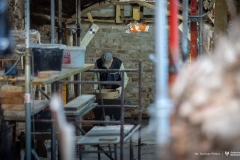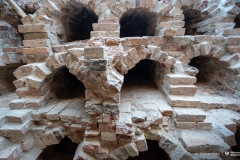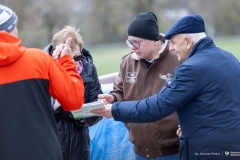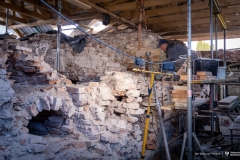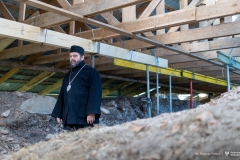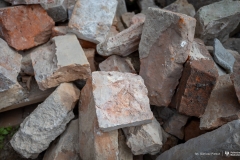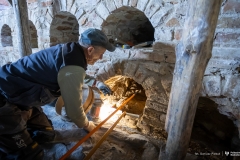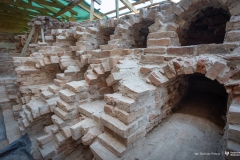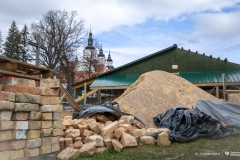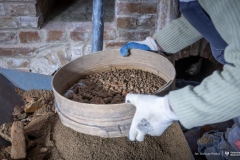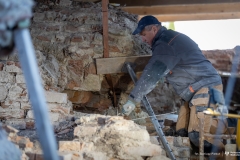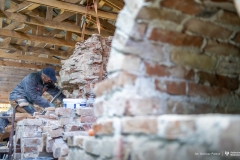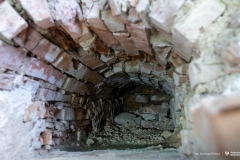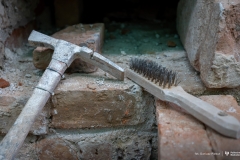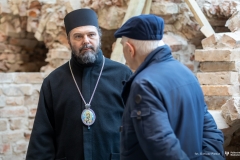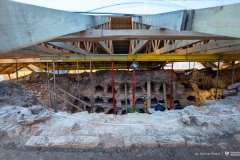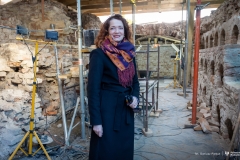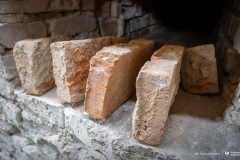Bialystok University of Technology is Saving the Supraśl Catacombs. Traces of a Former Church
09-04-2025
In 2021, the rectors of four Polish universities – Bialystok University of Technology, the University of Bialystok, the Medical University of Bialystok, and the Christian Theological Academy in Warsaw – launched a mission to save the 16th-century monastic catacombs in Supraśl. As of early April, the works are well advanced.
– Staff of Bialystok University of Technology are heavily involved in the renovation of the Supraśl catacombs – said Assoc. Prof. Marta Kosior-Kazberuk, DSc, PhD, Eng, Rector of Bialystok University of Technology and Head of the Department of Building Structures and Structural Mechanics at the Faculty of Civil Engineering and Environmental Sciences. – What matters most here are competencies such as knowledge of structural mechanics, construction mechanics, and above all, building materials. The works in the catacombs were preceded by unique research into the technical condition of bricks and binders, including their mechanical and physical properties such as absorbability, as well as susceptibility to biological corrosion. All of this is essential to properly address such a structure – to select appropriate repair materials and secure it effectively, so that what we do today, with so much effort, will be durable, and the catacombs can be admired by visitors from around the world.
Researchers from Bialystok University of Technology are now permanently present in the Supraśl catacombs.
– Bialystok University of Technology, especially the Department of Building Structures and Structural Mechanics, is helping to restore the original structure. We are also dealing with elements that need to be reinforced due to significant degradation over the years – said Robert Grygo, PhD, Eng. from the Department of Building Structures and Structural Mechanics at the Faculty of Civil Engineering and Environmental Sciences. – After the inventory, we proposed ways to reconstruct the catacombs. Some bricks need to be cleaned, some replaced – but in a way that matches the original assumptions. We studied the mortars previously used and are trying to preserve historical construction techniques.
Alongside restoration work, archaeologists continue to search for traces of the past.
– We discovered walls 90 cm thick – probably remnants of the former church that protected the catacombs – said Assoc. Prof. Maciej Karczewski, PhD, archaeologist working in the Supraśl catacombs. – We have also identified irregularities in the masonry and a transverse arch that may have supported the weight of the church above the catacombs.
The goal is to determine the location and dimensions of the Resurrection Church, a sacred structure described in historical records, which existed until the 1870s.
– A large niche was made, probably directly under the altar, and there is a record of a red-painted coffin in the catacombs used to carry the deceased – Karczewski continued.
Therefore, Bialystok University of Technology will soon begin a geodetic survey. All efforts aim to recreate and preserve the unique cultural heritage of the Polish–Lithuanian Commonwealth.
– We had been meeting for nearly two years before the actual work on the catacombs began, and those meetings have already yielded visible results – said Bishop Andrzej of Supraśl. – The work is progressing, and we are in constant consultation with specialists from various fields at Bialystok University of Technology. We are very grateful to have access to top-class experts right here, without needing to look across Poland.
The current priority is to preserve the monument.
– Once we secure this structure, the next step will be to apply for funding to provide suitable coverage and protection in line with the concept and design by Prof. Jerzy Uścinowicz – the bishop added.
The protection plan for the Supraśl catacombs was first presented by Prof. Jerzy Uścinowicz, DSc, PhD, Eng, Arch, Head of the Department of Architecture of Local Cultures at the Faculty of Architecture of Bialystok University of Technology, during the multimedia panel “Supraśl Catacombs – History and Future” at the Supraśl Academy in summer 2022. For now, the priority is to maintain the so-called “permanent ruin” in the best possible condition.
– At the moment, we are reinforcing the walls on both sides – said Eng. Aleksy Mularczyk, construction inspector from the Supraśl Monastery. – Several niches have already been reinforced. Plans also include comprehensive cleaning, priming, and silicate-based impregnation. Bialystok University of Technology is providing ongoing consultation on how to proceed in cases of structural instability.
Because the work of a civil engineer can involve a series of fascinating, unique challenges.
– The role of a civil engineer is not just about designing and constructing new buildings – reminded Assoc. Prof. Marta Kosior-Kazberuk, DSc, PhD, Eng, Rector of Bialystok University of Technology. – We often need to apply our skills in renovation, restoration and reconstruction of damaged structures. These are often historical buildings, hundreds of years old, which are part of our cultural heritage. Renovation requires expertise and is always an exciting adventure – involving research, the discovery of new possibilities, new construction and repair techniques. Civil engineering can be an inspiring journey that brings enormous satisfaction.
In spring 2024, the Monastery of the Annunciation of the Blessed Virgin Mary in Supraśl obtained funding through the Polish Deal programme for initial works to protect the Supraśl catacombs against further degradation.
The funding enabled intensified research work – archaeological, architectural and structural – and, most importantly, reinforcement of the damaged structure and efforts to bring it to the state of a so-called “permanent ruin”, halting further destruction.
In 2021, the rectors of four Polish universities – Bialystok University of Technology, the University of Bialystok, the Medical University of Bialystok, and the Christian Theological Academy in Warsaw – launched a mission to save the 16th-century monastic catacombs in Supraśl. Their goal was to conduct joint, interdisciplinary research and expert assessments to evaluate the condition of the catacombs, develop the foundations for their restoration and conservation, and support future conservation efforts for this remarkable monument, which was granted the status of Historic Monument of the Republic of Poland in 2023.
The years 2022–2023 were marked by numerous key initiatives involving scientific studies of the current condition of the catacombs and their surroundings. These included registration and design works, typological and comparative queries, especially in the fields of theology, archaeology, architecture, heritage protection and conservation, history, art history, anthropology and materials engineering. In the first stage, archaeological and architectural-conservation research and analysis were conducted to establish the substantive foundations for conservation, as well as ground-penetrating radar and excavation studies to help determine the boundaries of the burial ground around the catacombs. At the same time, intensive historical and architectural queries and analytical work were carried out to reconstruct the history of the catacombs, with particular emphasis on their construction, alteration and destruction after being abandoned, as well as to identify their original form and those buried within.
At the end of 2023, the Military University of Technology joined the #ratujemykatakumby initiative. Researchers from the Nicolaus Copernicus University in Toruń are also involved.
by jd

